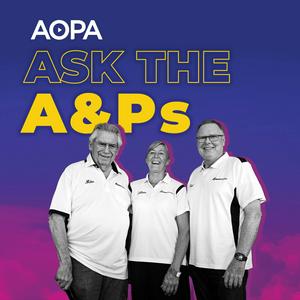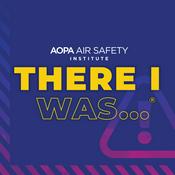95 episodes

"Just be sure you lube it with something"
12/15/2025 | 44 mins.
Pre-emptive engine overhauls, upgrading an old electrical system, spark plug anti-seize, and old wood wing concerns are on tap for this episode. Send your questions to [email protected] for a chance to get on the show. Join the world's largest aviation community at aopa.org/join Full episode notes below: Lance inherited some furniture that had lived in the Midwest for 200 years, and began splitting after only a few years after he moved to Salt Lake City. He's wondering if the same concern would hold with wood wings, like those on the Bellanca Viking. The hosts say not to worry. The wood spars are lathered with a varnish that helps keep out moisture, Sitka spruce is resistant to splitting, and Mike said in his experience with Vikings in the 1970s, shops didn't report issues with airplanes that had lived in different parts of the country. Jim has an Arrow and he wants to guard against the long down times we're seeing at overhaul shops. To do so he wonders if she would pick the right time and pre-emptively overhaul his engine, or at least change out the cylinders. Mike, Paul, and Colleen fully lecture poor Jim on the perils of so-called top overhauls, and instead advise him to do nothing more than stock a cylinder in case the time comes and he needs it. Darren is thinking of putting an all-new panel into his Tri-Pacer, and he's wondering if he should upgrade his generator to an alternator when he does it. Paul said he's not worried about the generator when it comes to his avionics, but given that Darren flies at night, Paul thinks an alternator is probably a good idea. Steve is wondering about spark plug anti-seize compounds. He uses the Tempest and Champion products, but found Lycoming's service instructions that prohibits their use. It calls for a copper-based compound, or motor oil. The hosts think the guidance might be a result of getting the carbon-based anti-seize on the insulator, which would cause arcing. They all agree that motor oil would be a bad choice. Paul thinks the Champion compound is fine, so long as you use only a little, and keep it off the last thread. Mike now uses an anti-seize stick that you apply to the threads, almost like a lip balm.

"If you go to 76 percent, the wings will fall off"
12/01/2025 | 51 mins.
A creative modification, lean of peak with turbocharging, electronic ignition, and oil leaks are on tap. Email [email protected] for a chance to get on the show. Join the world's largest aviation community at aopa.org/join Full notes below: Tom has a turbocharged Mooney and he's wondering how to manage it while lean of peak. The hosts say the first goal is to get on the lean side quickly, and then fine tune once there. They argue you can hear and feel when you're lean of peak, which is how you can expedite it. Then check the CHTs and the TITs to make sure they are below limits. That's it. Paul said in that way turbos have an advantage because it doesn't at what altitude you lean, the numbers should be similar. He tends to lean based solely on fuel flow. Ray is considering going to dual electronic magnetos, but he's concerned about redundancy and the safety of the associated battery. The hosts talk at length about the benefits of dual e-mags, and think that redundancy is better with e-mags than traditional magnetos, so even though you're going away from two independent systems, it's still an improvement. Mike said the TSO for the battery containment is extremely high, and not to worry about thermal runaway. The company must also think so because apparently the experimental version is largely the same, minus the same battery containment. Eric is a new A&P and he's trying to become better informed on the difference between major and minor overhaul. He helped a friend create an external charging port for a battery minder on the belly through an inspection port. The hosts are wowed by the work, and want to do it themselves, and all agree it's a minor alteration. It doesn't stick out into the airflow any more than a GPS antenna, which is a minor alteration. Mike recommends reading FAR Part 1.1, which gives the definition of a major alteration. If it doesn't meet that definition, it's minor. But of course Eric is a scientist by day and doesn't love the ambiguity of the reg. Mike says it's in his best judgement, and part of his role as a mechanic. Walter is trying to track down an oil leak on his Beech Sierra. Over a few years he's had his mechanic address multiple trouble spots, and over time that's helped. But recently he's had some oil pooling on his lower cowling. Colleen thinks areas such as oil return lines are problematic. The rubber boots connecting those lines get worn out and can be replaced. She's been trying to track down an oil leak on her Lycoming without luck, and gives Walter a bunch of places to check.

"It's one of the few accidents where you get to choose where it happens"
11/15/2025 | 52 mins.
Mike, Paul, and Colleen dig deep for some detailed troubleshooting on digital fuel indicators, oil temperature, gear problems, and more this episode. Send your questions to [email protected] for a chance to get on the show. Join the world's largest aviation community at aopa.org/join Full notes below: Will's fuel indicators are giving off infrequent red Xs on his Garmin G1000, and it started happening right after maintenance. Paul is suspect that a mechanic caused it, especially because you have to take the wings off to get at the sensors. But he's pleased at Will's level of troubleshooting, which includes info about what happens when the tanks is full, half full, and while turning on the ground. Based on the information, Paul is sure it's a sensor issue. On computer-based fuel indications, a mismatch between multiple sensors can often result in the EFD showing red Xs, he says. It turns out Will's mechanic was able to fix the problem by checking the connectors in the same inspection panel he had opened for the annual. Brad has a Cessna 182 that he keeps in a dry climate but is now flying to the Texas Gulf Coast a few times a month, where it sits for three days. He's wondering how to hold back corrosion. Paul suggests he wash the airplane when he gets home each time, and make sure the inside is fogged with Corrosion-X. Mike said not to worry too much about the engine because his single-weight oil and CamGuard will help protect it for those three days. Carl has a Cessna 210 and twice the landing gear motor didn't stop running when he cycled the gear. Paul then spends a few minutes describing the 210 gear system in great detail, including all the safety of wallet issues. The oil temp is high (235 degrees) on one of the engines on Ben's Twin Comanche. The hosts go through a slew of troubleshooting steps, most of which Ben has already performed. The hosts settle on this being an airflow issue, and not a fuel issue. Mike said the oil temp limit is an oil longevity concern, not an engine damage concern.

"Being an aircraft owner is the hardest job in aviation"
11/01/2025 | 51 mins.
From maintaining aircraft records to dealing with bad advice and sub-standard parts, Mike, Paul, and Colleen say being an aircraft owner is one of the hardest jobs in aviation. Email your questions to [email protected] for a chance to get on the show. Join the world's largest aviation community at aopa.org/join Full notes below: Randy wants to know if circuit breakers have a life limit. He has a Mooney with about 3,000 hours. He had one that was acting up, and was wondering if he should intentionally exercise or change them on some interval. Paul said he recommends to all his clients that they exercise their breakers every few years, since they do tend to corrode. Just tripping it breaks oxidation off the contacts, he said. If you check the resistance before and after the resistance often goes down. Colleen said she replaces a few breakers during each annual. Gary owns a Lake Amphibian with a IO-360 and he runs with fine wire plugs. At the last annual he found four of his Champion plugs had infinite resistance. They otherwise seemed to function normally. He’s wondering what the implications are? Paul said he has boxes old boxes of new Champion plugs that he can’t force himself to throw away, but he refuses to give them away either because he doesn’t trust them. The hosts said they’ve seen many problems with Champion fire wire plugs and the insulators. So they’ve stopped using them and suggest others do as well. They all endorse the massive electrode Champions are just fine, however. Chris helps clients establish aircraft logbooks after they buy their first airplane. Paul said: You should keep as much of the maintenance records as possible for value. Old invoices he puts in a bag and sets them aside. He keeps weight and balance history and it’s nice to have a 337 record. Only the current equipment list is necessary. He’ll recommend customers organize their own logbooks and not pay him to do it. Colleen also keeps a separate spreadsheet for time in service of all the airplane’s components. That makes it easy for inspection, replacement, and for ADs. Mike’s records include a big Word doc that includes all his maintenance records and a spreadsheet with the weight and balance, equipment list, and so on. Paul suggests only giving your maintenance provider a thumb drive so they can’t hold your logbooks hostage, nor do anything else you don’t approve of. Then when you’re ready to leave, you get the thumb drive and the sticker to go in the logbook when you get home. Paul read an article that advised against leaning too quickly and leading to washboarding of cylinders. Mike thinks that came from an old service bulletin. He said it needs to be taken in context. They were talking about heating the cylinder too fast. They weren’t talking about the transition from rich of peak to lean of peak, but rather a very rich mixture to a slightly less rich mixture. The piston heats faster than the cylinder barrel, and it expands faster than the cylinder. The piston could potentially cause metal to metal contact.

"That's an urban legend"
10/15/2025 | 49 mins.
What's in our oil, how to keep cool (and warm), and lean of peak are on tap for this episode. Email [email protected] for a chance to get on the show. Join the world's largest aviation community at aopa.org/join Full episode notes below: Mark flies a 182 and he read on a forum that the reason we've had so much spalling of lifters is because they took zinc out of the oil. Mike said this rumor has been going around for years, but doesn't make sense considering zinc was never in aviation oil. It's in STP, which is used as a thread lube. He cautioned not to put that in the engine because it's not ashless. The problem with lifters has been poor manufacturing, Paul said. Bob has an RV-10 and he's been trying to run lean of peak with wide open throttle. His technique has been to reduce rpm to get to 55 or 60% power and then lean. But doing so puts him at around 2,000 rpm. He's worried that running it too low might result in problems. Mike gives Bob a better technique. He said the mixture controls power while lean of peak, although running at a lower rpm is generally better since the combustion event takes longer. By running a lower rpm you're giving the engine more time to burn through the available fuel/air mixture. The low rpm prohibition that Bob is worried about in other airplanes is usually the result of propeller resonance issues, they say. Jeremy wants to know when to plug in the pre-heater. Other pilots have told him he needs to plug it in 10 to 12 hours before flying, but he's checked the temperatures with his engine monitor and found they rise about 35 degrees above ambient in two hours. Paul cautions that the oil won't be that warm, only the metal at the CHT probe, but because Jeremy is running multi-weight oil it doesn't matter. Mike said his rule of thumb is generally to preheat when it gets below 32 degrees F, and that when the rocker covers no longer feel cold to the touch that you're done. In Jeremy's case they agree that two hours seems fine. Johann has a Cessna 210 that has a hot cylinder. He's gone over the baffling, which helped, but he's wondering what else to do. Paul tells Johann to throw fuel at the problem. He sets the fuel flow a half-gallon to one gallon over the book number, advising that you'll know you've done too much if it runs rough at takeoff. With Johann's intercooler, he recommends even more. Because intercoolers bring more dense air into the engine, you have to adjust the fuel flow, although the manufacturer doesn't say how much. So it takes some trial and error. Paul also advised Johann to look at his engine mounts and considering installing an aftermarket prop. On the 210 a tight tolerance between the spinner and the cowling can greatly reduce temperatures. If the spinner is low you can raise it with new mounts or spacers under the front mounts.
More Education podcasts
Trending Education podcasts
About Ask the A&Ps
Listen to Ask the A&Ps, Digital Social Hour and many other podcasts from around the world with the radio.net app

Get the free radio.net app
- Stations and podcasts to bookmark
- Stream via Wi-Fi or Bluetooth
- Supports Carplay & Android Auto
- Many other app features
Get the free radio.net app
- Stations and podcasts to bookmark
- Stream via Wi-Fi or Bluetooth
- Supports Carplay & Android Auto
- Many other app features


Ask the A&Ps
download the app,
start listening.









































